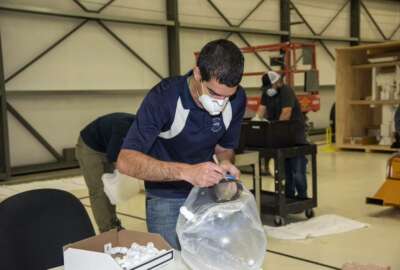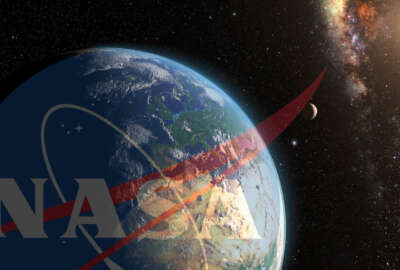
NASA wants to hack its way against coronavirus
For years, NASA has been inviting coders and scientists to an annual hackathon called Space Apps. This year it is aimed at the coronavirus.
Best listening experience is on Chrome, Firefox or Safari. Subscribe to Federal Drive’s daily audio interviews on Apple Podcasts or PodcastOne.
For nine years, thinkers at NASA’s science mission has been inviting software coders and scientists to an annual hackathon aimed at helping out with real-world problems. The program is called Space Apps. This year’s there’s an early, extra edition of Space Apps aimed at, you guessed it, coronavirus. For some details, the acting deputy director of NASA’s Earth Science Division, Dr. Paula Bontempi, joined Federal Drive with Tom Temin.
Interview transcript:
Tom Temin: Dr. Bontempi, good to have you on.
Dr. Paula Bontempi: Thank you so much for having me.
Tom Temin: First of all, give us the big picture of Space Apps, how it all works normally.
Dr. Paula Bontempi: Oh, Space Apps. It is like rolling the most positive energy of groups across the world that want to tackle real world problems into a weekend of craziness. So NASA invites coders, scientists, storytellers, artists, engineering enthusiasts and tinkerers into a virtual hackathon that last 48 hours. We do this every year. It’s usually in October. And in that 48 ours, participants from around the world have virtual teams and they use physical teams and they use Earth observations and other resources of NASA’s to actually try and come up with solutions for those practical world challenges.
Tom Temin: And what are some examples of challenges in the past that you’ve tackled?
Dr. Paula Bontempi: Oh, coming up with a new art or marketing campaign for human exploration in our solar system and beyond cleaning debris and plastics from the world’s oceans, and many, many things like that.
Tom Temin: All right, so this year, normally, this takes place in the fall, but right now you have just launched one, a special Space Apps for COVID-19 and coronavirus. Tell us what’s going on.
Dr. Paula Bontempi: Right. So with our partners, the European Space Agency and the Japanese Aerospace Exploration Agency, ESA and JAXA, respectively, on the 30th and 31st of May, NASA will invite those same groups of space enthusiasts entrepreneurs, storytellers, etc, into a virtual hackathon. And those virtual teams will use Earth observation data from satellites and other resources that the agencies make free and open to the world to address and come up with solutions for issues that are related to the COVID-19 pandemic. And I know this is something that of course is affecting our global communities. So the challenges will have a range of studying the coronavirus and what causes it and it’s spread to actually the impact the virus is having on the earth itself.
Tom Temin: Yes. How can Earth observation data though, really help with something that you can’t see even down here on earth?
Dr. Paula Bontempi: Great question. So one of the things that Earth observation data can be used to address are things like before and after people started quarantining was there a change in something like air quality or water quality and this can be in your backyard, or it can be on a global scale. And one of the things that’s very advantageous of satellites and satellite observations of our Earth is that you not only can look at one area of our planet in a snapshot in space, but you can also look at what those changes are over time. And I call that exploring and the temporal dimension. And what that does is gives you a picture of what some property of the Earth on land in the ocean and the atmosphere for example, look like before the quarantine and after. And what that does, it gives you some insight into perhaps how human practices or just you know what’s going on in Earth’s environment can change and be managed for sustaining resources in the future.
Tom Temin: Well, that’s an angle I hadn’t heard. Is there evidence so far that some Earth observable or satellite observable Earth phenomena have changed as a result of something to do with coronavirus?
Dr. Paula Bontempi: Yes, sir. It is something I think all of the space agencies have been taking a close look at starting with things like air quality. And what’s happened as people shelter in place, there are pollutants in the atmosphere like nitrogen dioxide, for example, which comes from the burning of fossil fuels and things like power plants. And while the drop that we’ve seen from the levels in the atmosphere before the quarantine and after have been dramatic, the research is now underway to see if that’s attributable to something like a change in emissions, versus other things that affect nitrogen dioxide in the atmosphere, like weather patterns and what’s going on in tropospheric and stratospheric or the different levels of the atmosphere. So there are many things that can affect what’s going on in the earth. And we’re just trying to separate out and identify what those changes are related to what’s happening with the virus.
Tom Temin: And in this hackathon, this virtual hackathon that will occur at the end of the month, what is the incentive for people? Is there a challenge grant that they get or what happens?
Dr. Paula Bontempi: It’s a really good question. So we are finalizing the details of what we’re tentatively calling an award at the end. But one thing we really like to facilitate among the agencies is to see those winners of the different challenges actually have their proposed solutions and solutions phase transitioned or facilitated into operational use by managers and policy makers out there to better inform them. And so that is something I think all of the agencies feel very strongly about. Not that you just win the challenge, but that we actually adapt the winner solution space for some good use in the future.
Tom Temin: Because the example you gave is that there is an improvement in things less emissions, because people aren’t driving so much, presumably. So what might be solvable here? Because when this whole thing passes to some degree people are going to start driving again.
Dr. Paula Bontempi: Yes. And so it’s very important than, exactly. So it’s very important for the agencies and researchers to understand whether those changes in some aspects of the Earth are driven by, you know, human made practices, like commuting, as you alluded to, or whether they’re naturally driven and teasing those out what the drivers of those changes are for our Earth system. A part of what we want our hackathon participants to think about, right? What can we attribute to natural properties and what’s man need and how can that better inform management moving forward?
Tom Temin: Who knows maybe the virus consumes CO2 and produces oxygen.
Dr. Paula Bontempi: (Laughing) I’m not sure if that’s the case, but it’s quite possible that our clever people participating could identify or learn something about the virus and its spread, and how the environment is facilitating that spread using the space space data. I mean, the sky’s the limit.
Tom Temin: Sure, literally. And with respect to some of the people that are involved, I can understand coders and scientists, but you mentioned storytellers and people like that, artists. Sounds charming, but what can a storyteller do here?
Dr. Paula Bontempi: Oh, that’s a great question. Well, as you know, I mean this global pandemic is affecting everybody, right? And so the hackathon is usually people participate, whether they’re in like kindergarten, we’ve had some that young, straight through, you know, adults and professionals, and everybody has been affected by things like social isolation. And so one of the things we’ve been talking about is whether we can come up with a way or a challenge to allow everybody out there who can pick up a pen and draw a picture, for example, to express what the social isolation And what the hope of finding a solution actually means to them. And we’ve been talking about how to engage the broad community in a way like that, whether it’s through an essay or a piece of art that they create that allows them to express how they feel.
Tom Temin: Alright, then a final question then who decides who the prize winners or awardees or which ideas get chosen for further development?
Dr. Paula Bontempi: Good question. So each of the challenges will have subject matter experts from the agency and its partners, as well as judges who go through every single project that is submitted in response to a challenge and spend time talking about it and select the winners accordingly. And then we post those winners on our website. In the past for Space Apps, we’ve invited those winners to a launch at NASA and certainly we’re working out the details of how that might be possible moving forward with our partners ESA and JAXA.
Tom Temin: Dr. Paula Bontempi is Acting Deputy Director of NASA’s Earth Science Division. Thanks so much for joining me.
Dr. Paula Bontempi: Thank you so much for the opportunity and stay safe everyone.
Read more about the hackathon.
Copyright © 2025 Federal News Network. All rights reserved. This website is not intended for users located within the European Economic Area.
Tom Temin is host of the Federal Drive and has been providing insight on federal technology and management issues for more than 30 years.
Follow @tteminWFED





